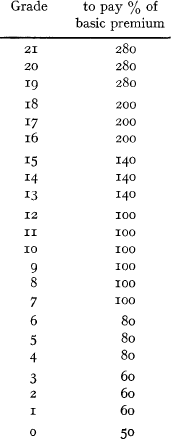Article contents
Experience rating and credibility
Published online by Cambridge University Press: 29 August 2014
Extract
Let me begin with some practical examples of experience rating.
a) Swiss Automobile Tariff 1963
— Within each tariff-position there are 22 grades:

— The new owner of a car starts at grade 9
— The basic premium is determined on the basis of objective characteristics of the risk and essentially depends on the horse-power classification of the car
— The 22 grades are experience-rated as follows: For each accident one rises three grades and for each accident-free year one falls one grade. A driver who has I accident in every 4 years hence remains within four adjacent grades.
b) Sliding Scale Premiums in Reinsurance
Excess of Loss Contracts often stipulate that:
The rate of premium to be applied to the subject premium volume is determined at the end of the cover period as follows:

subject to a minimum of 0,04
and a maximum of 0,08
c) Participation in Mortality Profit in Group Life Insurance
A group life insurance covers the members of the group on a one year term basis. It is often agreed that at the end of the year mortality profits are given back to the group according to the formula
refund = x% gross premiums — y% claims (where x < y)
All these examples fall under the heading “Experience Rating”. What do they have in common?
Definition: A system by which the premium of the individual risk depends upon the claims experience of this same individual risk.
- Type
- Astin Colloquium 1966 Arnhem
- Information
- Copyright
- Copyright © International Actuarial Association 1969
References
- 44
- Cited by




